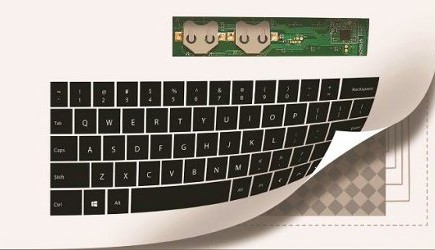Printed Electronics: Paper Keyboard
February 20, 2014
on
on

UK startup Novalia demoed an ultra-thin fully functional keyboard printed with conductive ink.
Camebridge-based Novalia aims to add low-cost electronic features to everyday items like newspapers, packaging and posters. The company developed a new method to add electronic components to plastic and paper using ordinary roll-to-roll printing processes. To show the capabilities of the patented process, Novalia combined printed electronics with a System-on-Chip (SoC) to produce a paper keyboard.
Using only conductive ink and no additional metallic wiring a matrix of capacitive touch sensors is printed on a sheet of photo paper. The layout of the keys is printed on ordinary A4 paper and placed on top of the matrix. The keyboard connects wirelessly to a smartphone over the Bluetooth enabled SoC. The SoC, manufactured by Nordic Semiconductor, can be configured to adjust the functionality of the keyboard.
Novalia founder and CEO Kate Stone said in a press release: "The really clever bit is being able to literally print touch sensors, with no metallic wiring, using local existing print processes anywhere in the world, and so at very low cost. And the functionality of all of these devices is defined in software and so could be shipped digitally."
Kate Stone told News 3.0 she regrets the disappearance of physical objects such as books and newspapers as they are being replaced by E-alternatives. By integrating electronics into these items she hopes to create objects with the best of both worlds.
Camebridge-based Novalia aims to add low-cost electronic features to everyday items like newspapers, packaging and posters. The company developed a new method to add electronic components to plastic and paper using ordinary roll-to-roll printing processes. To show the capabilities of the patented process, Novalia combined printed electronics with a System-on-Chip (SoC) to produce a paper keyboard.
Using only conductive ink and no additional metallic wiring a matrix of capacitive touch sensors is printed on a sheet of photo paper. The layout of the keys is printed on ordinary A4 paper and placed on top of the matrix. The keyboard connects wirelessly to a smartphone over the Bluetooth enabled SoC. The SoC, manufactured by Nordic Semiconductor, can be configured to adjust the functionality of the keyboard.
Novalia founder and CEO Kate Stone said in a press release: "The really clever bit is being able to literally print touch sensors, with no metallic wiring, using local existing print processes anywhere in the world, and so at very low cost. And the functionality of all of these devices is defined in software and so could be shipped digitally."
Kate Stone told News 3.0 she regrets the disappearance of physical objects such as books and newspapers as they are being replaced by E-alternatives. By integrating electronics into these items she hopes to create objects with the best of both worlds.
Read full article
Hide full article


Discussion (0 comments)